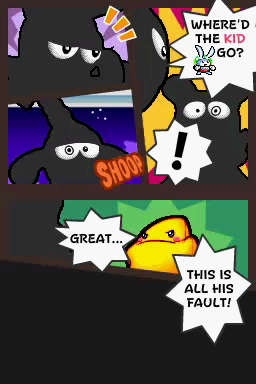The Legendary Starfy/Regional differences
This article or section is incomplete.
| |

|
You can add to it by clicking the edit button at the top of the article. Reason given: Stuff differences, differences in character names. |
During the localization process of The Legendary Starfy, various changes were made to the game so that it would appeal to North American and Australasian audiences.
This article covers regional differences in the game. For other differences relating to the game's distribution, including box and manual, see here.
Title Change
This game was originally released as Densetsu no Stafy Dairu Kaizokudan (Japanese: 伝説のスタフィー たいけつ!ダイール海賊団), literally Legendary Starfy Dire Pirate Squad in Japan. Dire Pirate Squad (English games: The Terrible Trio) refers to the group who are trying to capture Rampa (English: Bunston) under Daīru (English: Mashtooth)'s orders.
The game was released outside of Japan simply as The Legendary Starfy, presumably because it is the first game in the series to have been released outside of Japan, so the rest of the title wouldn't have been needed to differentiate it from the other four games.
Stuff differences
This section describes differences in the Stuff between the Japanese and English versions.
See also The Legendary Starfy/Stuff for a list of Stuff in the game.
Japanese names
Most of the Stuff did not receive literal translations. The table below lists a number of notable changes.
Clothes
|
Regional Differences
Various changes were made to the appearance of the Stuff between the localisations and the original Japanese version.
Doctor's Coat
Manga-style cutscenes
The Japanese version's Story cutscenes appear on the screen from right-to-left in the style of manga. According to Miki Fuji, the original game was made 'with the Japanese manga culture in mind' but when The Legendary Starfy was brought to America, a number of changes were made to the Story cutscenes so that they read from left-to-right instead of right-to-left. [1]
Japanese onomatopoeia were either changed or removed in the localisations. For example in the 'The Adventure Begins' cartoon, きょろ (onomatopoeia for searching for someone with one's eyes) was replaced with 'shoop'.
A section of the 'The Adventure Begins' cartoon in the North American version. Note that Starfy, Snips, Papes and Ronk were flipped in the process of making the strip read from left-to-right
Mermaid's voice
In the Japanese version, the Mermaid exclaims 'hi-hi', instead of 'hi'. The Mermaid previously exclaimed 'hi-hi' in Densetsu no Starfy 4, although the voice in Legendary Starfy Dire Pirate Squiad is higher pitched than the one in Densetsu no Starfy 4.
Moe's voice
In the Japanese version, there are a number of situations where Moe will exclaim something. This voice was removed in the localisations.
These include:
- Moe jumping on the exit platform at the end of Stage 1-1 (Gluglug Lagoon).
- Being shown Moe's advice after taking a second hit in the Rock-Paper-Scissors game.
- Moe's reaction after Starfy pushes The Moon into Mega Mashtoooth (Strongest Dairu, さいきょうダイール in Japan).
Narrations
There are a number of narrations in the game that are exclusive to the Japanese versions.
Name of game
In the Japanese version, on the screen where 'Adventure' or 'Local Wireless' can be chosen, a Japanese voice can be heard shouting the name of the game; "Densetsu no Starfy Dairu Kaizokudan".
Jan-ken-pon
In the Japanese version, voices are used in the Rock, Paper Scissors game to reflect the common rules of Janken (Rock-Paper Scissors).
Nintendo
When the game is started up, the Nintendo logo is shown on the top screen, while Starfy and Starly are shown running up to each other to join their hands on the touch screen.
In the Japanese version, after Starfy and Starly touch their hands a female voice is heard shouting 'Nintendo!'. After beating the game there is a chance that a longer version of the same voice is heard.

